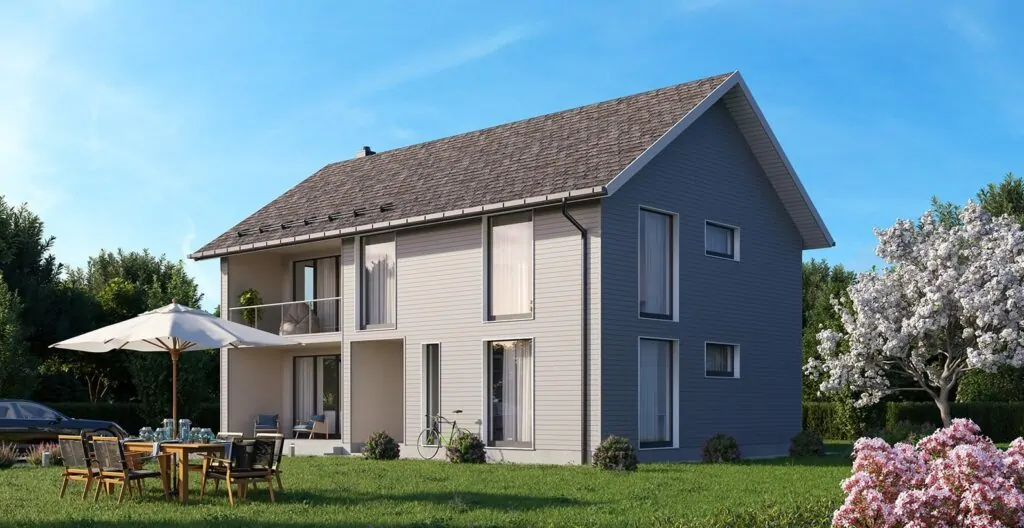A wooden house offers enjoyable advantages in terms of comfort, climate as well as health or environment. Wood is a bioenergetic and ecological material. Flexible, resistant, light, and durable, wood is suitable for most grounds and constructions. It is also recommended in seismic areas.
The structure is solid due to tensile and weight strength. Wood prevents dust circulation and static electricity. The humidity level is naturally low in the construction. The wood material is easy to maintain and offers physiological and psychological advantages. A wooden house will make you benefit from a healthy, warm, comfortable, and balanced interior.

In wooden house Estonia#3, the floor plans are organised around the central staircase and facing the entrance.
Prefabricated houses are modern housing constructions. They are fast and easy to assemble and ahead of more common housing buildings in terms of performance and energy efficiency. Wood is an energetic, recyclable, and ecological material. As the main component of the construction, it ensures the proper insulation of the house, keeps the warmth, and protects it from cold. You can find more specific info here about benefits of a log home.
Wood is naturally breathing and offers a balanced and healthy living environment. The modular house benefits from flexible layouts, and it is possible to extend them afterward. Modern wooden houses are an adequate solution to face current environmental issues while providing comfort, modernity, and contemporary design.
Sustainability of Building with Wood
- Wood is a renewable resource, meaning it can be replenished through natural processes. This contrasts with non-renewable resources such as fossil fuels, which are finite and cannot be replaced once used.
- One of the wooden house benefits is that it can help reduce greenhouse gas emissions. Trees absorb carbon dioxide from the atmosphere as they grow. Using wood products for construction instead of materials like concrete or steel can help reduce this carbon and offset some of the emissions associated with building.
- Wood is biodegradable, which can break down naturally over time and return nutrients to the soil. This contrasts with materials like plastic, which can take hundreds of years to decompose and contribute to pollution and waste.
Save Energy and Money with a Wooden House
- Wood is a natural insulator, meaning it can help keep a home warm in the winter and cool in the summer. This can help reduce the energy needed to heat and cool the home, leading to lower energy bills.
- Wooden houses can be designed and built to be highly energy efficient, with features like insulation, triple-paned windows, and energy-efficient appliances.
- Wood can be used to create tight, well-sealed buildings that can help prevent drafts and reduce heat loss.
The Durability of Wood
- Wood is a strong and durable material that can withstand the wear and tear of daily life.
- Properly maintained wooden houses could last for many years, with a lifespan of 60-100 years or more.
- Wood is resistant to pests and rot when treated with preservatives.
Aesthetics of Wooden House
- Wood has a natural beauty that can enhance the appearance of a home. Its warm, organic look adds character and charm to a building.
- Wood can be stained or painted in various colours to suit personal preferences and the style of the home.
- Wood can be used in many ways in a home, from structural elements like beams and rafters to decorative details like trim and cabinetry.
The Economic Advantages of Building with Wood
- Building with wood can be less expensive than building with other materials, especially in the long term.
- Wood is a lightweight and easy-to-work-with material, which can make construction quicker and easier compared to building with other materials. This can help reduce labour costs.
- The energy efficiency of wooden houses can lead to lower energy bills over time, further reducing the overall cost of owning a wooden home.
The Versatility of Wooden Houses
- Wooden houses can be easily modified or expanded as needs change over time.
- Wood is a flexible material that can be shaped and moulded to fit a variety of designs and styles.
- Wooden houses can be easily adapted to different climates and environments, with features like insulation and windows that can be tailored to specific needs.
- Read more about the benefits of log houses.
Quick Construction
- Wood is a lightweight and easy-to-work-with material, which can make construction quicker and easier compared to building with other materials.
- Prefabricated wooden components, such as trusses and panels, can be quickly assembled on-site, reducing construction time.
- Wooden houses can often be built faster than houses made of other materials, allowing you to move in and start enjoying your new home sooner.
How are wooden houses better than brick?
Here are some pros and cons of both wooden and brick houses to consider:
Pros of wooden houses:
- Wood is a renewable resource and can have a smaller carbon footprint than other materials.
- Wood is a natural insulator, which can lead to energy savings and a more comfortable living environment.
- Wood is a durable and long-lasting material that can withstand the wear and tear of daily life.
- Wood has a natural beauty that can enhance the appearance of a home.
- Building with wood can be less expensive than other materials, especially in the long term, due to its energy efficiency and durability.
- Wooden houses can be easily modified or expanded as needs change over time.
- Wood is a lightweight and easy-to-work-with material, making construction quicker and easier.
Ultimately, the decision to build with wood or brick will depend on your personal preferences, budget, and the specific needs and characteristics of your location. It is important to carefully consider all of these factors before making a decision.
